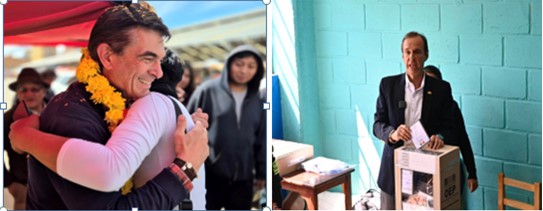
Bolivians will go to polls again in October to vote for president after none of the leading candidates secured the required minimum to be elected in Sunday’s first round.
In what is seen as a swing to the right after nearly 20 years of a leftist government, conservatives Rodrigo Paz and Jorge Quiroga came in first and second place, respectively, with 32.1% and 26.8% of votes.
Paz, a former lawmaker for Tarija department and past mayor of the city of Tarija, and Quiroga, a former president, were followed by businessman Samuel Doria, who received 19.9% of votes.
Eduardo del Castillo, of the ruling MAS party, and Andrónico Rodríguez, a former MAS member, garnered 3.16% and 8.22%, respectively.
A fragmented MAS, because of political infighting between President Luis Arce and Evo Morales, who was head of state from 2006 to 2019, coupled with a deteriorating economy and social unrest, would help explain election results.
Many have pinned hopes on the new government resetting the country, particularly the energy sector, and more specifically the hydrocarbons industry, which has seen lackluster performance.
Arce’s administration has acknowledged the need to overhaul the hydrocarbons legislative and regulatory framework to ease the State’s grasp, which began under Morales with the sector’s nationalization in 2006.
The policy change is coupled with the government’s upstream reactivation plan to increase production and replace reserves.
Such shifts would gain new impetus under Paz or Quiroga.
To learn more about the leading candidates’ energy roadmaps, BNamericas provides a snapshot of their proposals.
Rodrigo Paz
“Bolivia is facing a critical multidimensional situation, which has placed the economy, state institutions, and the judicial system on ‘intensive care’,” according to Paz’s government plan.
It adds: “Experts and organizations such as the Bolivian Society of Engineers and the Jubileo Foundation have denounced that the current energy model has failed due to a lack of investment in exploration and replenishment of reserves since the 2013 administration, and due to inefficient public policies that have failed to incentivize private investment or diversify the energy mix.
“The Society of Engineers warns that if the minimum fuel supply is not guaranteed in the coming months, the productive sector will suffer a severe blow that could lead to a food and energy crisis. Furthermore, a possible energy crisis is projected for 2030 if urgent measures are not taken to modernize infrastructure and diversify the energy matrix.”
Paz’s policy on this front is the reactivation of hydrocarbons exploration and production and the promotion of renewable energies through the following strategies:
Legal and fiscal incentives to attract investment in exploration and production Development and production start-up of new strategic deposits Strategic plan for exploration and expansion of reserves with technical cooperation and institutional strengthening Promotion and development of complementary renewable energies Optimization and modernization of energy infrastructure with public and private investment Sustainable management and subsidy reduction to ensure economic viability Restructuring of state hydrocarbons company YPFB and state power company Ende Modernization of the legal system that regulates the hydrocarbon and energy chain
His roadmap includes the need for safeguarding the environment and the responsible use of water resources, along with protecting indigenous peoples and communities.
[insight#259047307]
[insight#259047537]
Jorge Quiroga
For Quiroga, “the situation in this sector today is worrying. On the one hand, we don’t have sufficient gas reserves, the information the government provides is unclear, non-transparent, and unreliable. The reality is that we’ve already lost the Argentine market, we’re exporting less to Brazil, and if new deposits aren’t explored and discovered, we won’t even have enough to sustain the domestic market.
“More than 66% of electricity is produced with gas, therefore, if gas production doesn’t increase, we won’t have any energy.”
Among this candidate’s strategies are:
Raise domestic prices so that reserves that are currently unprofitable become profitable and oil can be refined (currently, the refineries in Santa Cruz and Cochabamba only process up to 35% of their capacity), lowering the cost of gasoline and diesel compared to imports Improve fuel purchasing logistics, with transparency and completely liberalizing fuel imports Target fuel subsidies, primarily for public transportation and those most in need; this immediately prevents fuel smuggling Use technology to prevent LPG smuggling Another incentive must be paid to producers in addition to the price of gas, so that reserves that are not profitable without the incentive become profitable and gas can be extracted Change the hydrocarbons law: the tax system must be competitive with the countries in the region Promote the production of biofuels Crude oil imports for refineries will be evaluated, utilizing the Arica-Sica Sica pipeline, instead of importing diesel and gasoline Change electricity legislation to encourage investment in renewable electricity generation, which would facilitate the gradual modification of the mix to achieve at least 50% renewable energy generation
[insight#260217538]
